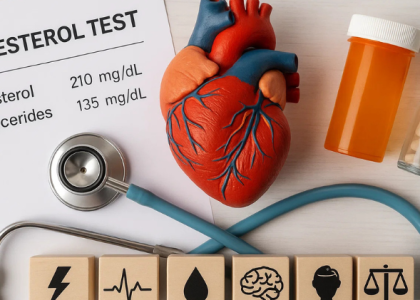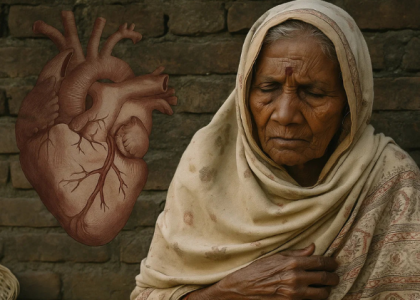Feeling tired all the time? Swollen feet? Trouble sleeping flat? These could be signs of heart failure — not just aging.
Many South Asians brush off these symptoms as “getting older” or “working too hard.” But according to the American Heart Association, South Asians develop heart disease up to 10 years earlier than other groups. This means we need to be extra vigilant about early detection.
The good news? Simple tests can catch heart problems before they become serious — and knowing which tests to ask for could save your life or the life of someone you love.
What Is Congestive Heart Failure (CHF)?
Congestive Heart Failure doesn’t mean your heart has stopped or is about to stop. It simply means your heart isn’t pumping blood as effectively as it should to meet your body’s needs.
Think of your heart like a water pump. In CHF, the pump is still working, but it’s become tired and weak. It can’t push enough water through the pipes to water the whole garden properly.
When this happens:
- Some parts of your body don’t get enough blood (causing tiredness)
- Fluid backs up in your lungs (causing shortness of breath)
- Fluid collects in your legs or belly (causing swelling)
According to the Cleveland Clinic, many people live with mild heart failure for years without knowing it. The symptoms can be subtle and easy to mistake for other conditions or just “getting older.”
The Tests That Can Spot CHF Early
Don’t wait until symptoms become severe. These tests can detect heart failure early, when it’s easier to treat:
BNP / NT-proBNP (Blood Test)
What it is: A simple blood test that measures a hormone called B-type natriuretic peptide.
What it shows: When your heart is under pressure or stretching, it releases this hormone. High levels = heart under stress.
Why it matters: This test can detect heart failure even before serious symptoms develop. The Mayo Clinic calls it one of the most valuable tests for diagnosing heart failure early.
Ask your doctor: “Can we check my BNP level to see if my heart is struggling silently?”
Echocardiogram (Heart Ultrasound)
What it is: An ultrasound that shows live pictures of your heart in action.
What it shows: How well your heart pumps blood, measured as “ejection fraction.” This is the percentage of blood your heart pushes out with each beat. A normal ejection fraction is usually between 55-70%.
Why it matters: This test can directly see if your heart is weak, stiff, enlarged, or not pumping effectively.
Ask your doctor: “Could we do an echo to see how strong my heart is pumping?”
Electrocardiogram (ECG / EKG)
What it is: A test that records your heart’s electrical activity.
What it shows: Your heart rhythm, rate, and whether you’ve had any previous heart damage that might be affecting function.
Why it matters: It can detect irregular heartbeats, past silent heart attacks, or heart enlargement — all of which can contribute to heart failure.
Ask your doctor: “Should we do an ECG to check my heart’s electrical activity?”
Chest X-ray
What it is: A simple image of your chest area.
What it shows: Whether there’s fluid in your lungs or if your heart is enlarged — both common signs of heart failure.
Why it matters: It helps doctors see if your heart failure is causing fluid backup or if your heart has become enlarged from working too hard.
Ask your doctor: “Would a chest X-ray help check if I have fluid in my lungs?”
Coronary Artery Calcium Score (CAC)
What it is: A specialized CT scan that checks for calcium buildup in your heart arteries.
What it shows: How much plaque has built up in your coronary arteries, which can block blood flow to your heart muscle.
Why it matters: Blocked arteries can lead to heart attacks, which damage heart muscle and often lead to heart failure. As mentioned in our downloadable guide “5 Life-Saving Heart Tests,” this test can detect plaque before you have any symptoms.
Additional Tests Your Doctor Might Recommend
- Stress Test: Shows how your heart works during exercise
- MRI: Provides detailed images of your heart structure
- Blood tests: Check for other conditions that affect heart health, like thyroid problems or anemia
When to Ask for These Tests
You should consider asking your doctor about these tests if:
- You feel unusually tired, even after rest
- You get short of breath when walking or climbing stairs
- You wake up at night needing to catch your breath
- You need to use extra pillows to sleep comfortably
- Your shoes feel tight or your ankles swell by the end of the day
- You have to get up frequently at night to urinate
- You have risk factors like diabetes, high blood pressure, or a family history of heart disease
- You’re over 45 and haven’t had a comprehensive heart check-up
The World Health Organization notes that South Asians should consider heart screening about 10 years earlier than recommended for the general population. This means starting these conversations with your doctor in your 40s rather than 50s.
What to Ask Your Doctor

Many doctors won’t automatically order heart failure tests unless you have obvious symptoms. Here are some helpful phrases to start the conversation:
- “I’ve been feeling more tired than usual — could we check if my heart is pumping normally?”
- “I’ve read that BNP blood tests and echocardiograms can detect early heart failure — is that something we could do?”
- “Even though I don’t have chest pain, could these symptoms be related to my heart?”
- “Given my South Asian background and higher risk for heart problems, which tests would you recommend to check my heart health?”
- “I’d like to be proactive about my heart health. What tests would you suggest for someone my age and background?”
Remember, you are your own best advocate. Don’t be afraid to ask specifically for these tests if you have concerns.
Early Detection Makes All the Difference
The Cleveland Clinic reports that when heart failure is caught early:
- Medications can significantly improve heart function
- Lifestyle changes can slow or stop progression
- Quality of life can be maintained or improved
- Hospital stays and emergency visits can be reduced
- Life expectancy can be extended by years or even decades
Many people with well-managed heart failure lead full, active lives. The key is catching it early before significant damage occurs.
Take Action Today
Don’t wait for a crisis to check your heart health. Here are three simple steps you can take today:
- Download our “5 Life-Saving Heart Tests” guide to learn more about essential screening tests
- Schedule a check-up with your doctor and bring this article with you
- Share this information with family members, especially those over 40 or with risk factors
Catching heart failure early means more energy, fewer emergencies, and a longer, healthier life. Don’t wait for a crisis — get ahead of it.
Your heart works hard for you every day. Taking these simple steps now can help ensure it stays strong for many years to come.
This article includes information from the American Heart Association, Cleveland Clinic, Mayo Clinic, and the World Health Organization, along with our downloadable guide “5 Life-Saving Heart Tests for South Asians.”




